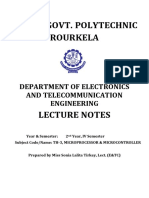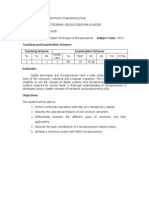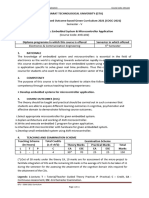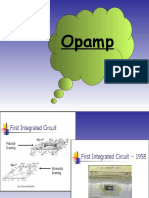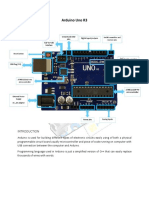MALP
MALP
Uploaded by
jainamshahCopyright:
Available Formats
MALP
MALP
Uploaded by
jainamshahOriginal Description:
Original Title
Copyright
Available Formats
Share this document
Did you find this document useful?
Is this content inappropriate?
Copyright:
Available Formats
MALP
MALP
Uploaded by
jainamshahCopyright:
Available Formats
Microprocessor and Assembly Language Programming Course Code: 3340302
GUJARAT TECHNOLOGICAL UNIVERSITY, AHMEDABAD, GUJARAT
COURSE CURRICULUM
COURSE TITLE: MICROPROCESSOR AND ASSEMBLY LANGUAGE
PROGRAMMING
(Code: 3340302)
Diploma Programmes in which this course is offered Semester in which offered
Biomedical Engineering 4th Semester
1. RATIONALE
Microprocessors are being excessively used in the field of medical instrumentation. This
course is intended to help the students to understand the architecture and programming of a
typical Microprocessor. The course will also deal with the architecture and introduction to
8085 and other advanced microprocessors. The course in addition, will provide knowledge of
block diagram of some microprocessor based medical equipment. Therefore, this course is
designed to develop in students the requisite cognitive and practical skills in performing
effectively as biomedical engineer.
2. COMPETENCY
The course content should be taught and curriculum should be implemented with the aim to
develop required skills in students so that they are able to acquire following competencies:
Interface the medical equipments and it’s attachments with microprocessor.
3. COURSE OUTCOMES
The theory should be taught and practical should be carried out in such a manner that students
are able to acquire required learning out comes in cognitive, psychomotor and affective
domain to demonstrate following course outcomes.
i. Identify different blocks of microprocessor.
ii. Correct the instructional syntax errors.
iii. Develop logic for data transfer and arithmetic and logical operations.
iv. Develop logic for branching and looping operations.
v. Identify different blocks of advance microprocessor.
vi. Enlist microprocessor based medical equipments.
4. TEACHING AND EXAMINATION SCHEME
Teaching Scheme Total Examination Scheme
(In Hours) Credits Theory Marks Practical Total
(L+T+P) Marks Marks
L T P C ESE PA ESE PA 150
4 0 2 06 70 30 20 30
Legends: L-Lecture; T – Tutorial/Teacher Guided Theory Practice; P - Practical; C – Credit; ESE - End
Semester Examination; PA - Progressive Assessment.
GTU/ NITTTR Bhopal/13-14 Gujarat State
Microprocessor and Assembly Language Programming Course Code: 3340302
5. COURSE DETAILS
Unit Major Learning Outcomes Topics and Sub-topics
(in cognitive domain)
Unit – I 1a. Draw and explain basic 1.1 Microprocessor Architecture
Micro- architecture of and its operation:
processor Microprocessor. Microprocessor initiated
Architecture & 1b.Explain the difference operations and 8085 bus
Micro- between Von Neumann and organization, internal data
processor Harvard architecture. operations and 8085 registers.
system 1c. Draw and explain block
diagrams of bus 1.2 Memory: Memory organization,
organization, memory map, memory read
Functional, and writes.
Programming model,
Pin-out diagram, 1.3 Microcomputer system
Signaling Diagram.
1d.Describe the 1.4 Microprocessor 8085: Block
Microcomputer diagram, address and data bus,
System. control and status signals,
1e. Describe the data bus, power-supply and clock
control signals, power frequency, interrupts and
supply and clock externally initiated operations,
frequency, Serial I/O serial i/o ports, bus timings,
ports and timing signal flags.
diagram.
Unit– II 2a. Classify various Instruction 2.1Instruction classification: Review
8085 set. of 8085 operations
Instruction and 2b. Describe different 2.2Instruction Formats: Single
Timing instruction syntax and its bytes, two bytes and three
emory occupation. bytes instructions, op-code
2c. Write simple programs format, instruction timings
using different instructions. and operation status, simple
programs.
Unit– III 3a. Explain different 3.1 Data transfer instructions.
8085 addressing modes. 3.2 Arithmetic instructions.
Instruction set 3b. Explain the purpose of 3.3 Logical operations.
various instructions. 3.4 Branch operations.
3c. Use instructions to write 3.5 Stack, I/O and Machine control
simple program. Instructions.
3.6 Simple programs using 8085
instructions.
Unit – IV 4a. Describe different types of 4.1. Looping, counting and
Programm-ing programming techniques. indexing.
Techniques 4b. Write simple programs on 4.2. Logic operations
different programming 4.3. Counter and timing delays.
techniques. 4.4. Stack and subroutines.
4.5. Code conversion, BCD
arithmetic and 16 bit data
operations.
GTU/ NITTTR Bhopal/13-14 Gujarat State
Microprocessor and Assembly Language Programming Course Code: 3340302
Unit Major Learning Outcomes Topics and Sub-topics
(in cognitive domain)
Unit – V 5a. Draw and explain basic 5.1 8086 /8088 architecture.
Advance block diagrams of 5.2 32 bit Microprocessor 80386:
Microprocessor 8086/8088 processors. Introduction/Architecture
and its medical 5b. Draw and explain block 5.3 The Intel Pentium processor:
applications. diagram of Pentium Internal block diagram
processor 5.4 RISC processor: Introduction
5c. Describe the RISC processor & features.
with its features. 5.5 Human body temperature
5d. Draw and explain block measurement using
diagram of temperature microprocessor.
monitoring system and 5.6 Microprocessor based
ECG. Electrocardiograph
(ECG)monitoring system.
6. SUGGESTED SPECIFICATION TABLE WITH HOURS & MARKS (THEORY)
Unit Unit Title Teaching Distribution of Theory Marks
No. Hours R U A Total
Level Level Level Marks
I Microprocessor Architecture &
12 14 07 00 21
Microprocessor system
II 8085 Instruction and Timing 08 02 08 02 12
III 8085 Instruction set 14 00 06 10 16
IV Programming Techniques 10 00 02 05 07
V Advance Microprocessor and its
12 10 02 02 14
medical applications.
Total 56 26 25 19 70
Legends: R = Remember; U=Understand; A = Apply and above levels (Bloom’s Revised taxonomy)
Note: This specification table shall be treated as a general guideline for students and teachers. The
actual distribution of marks in the question paper may vary slightly from above table.
7. SUGGESTED LIST OF EXERCISES/PRACTICALS
The practical/exercises should be properly designed and implemented with an attempt to
develop different types of skills (outcomes in psychomotor and affective domain) so that
students are able to acquire the competencies/programme outcomes. Following is the list of
practical exercises for guidance.
Note: Here only outcomes in psychomotor domain are listed as practical/exercises. However,
if these practical/exercises are completed appropriately, they would also lead to development
of certain outcomes in affective domain which would in turn lead to development of Course
Outcomes related to affective domain. Thus over all development of Programme Outcomes
(as given in a common list at the beginning of curriculum document for this programme)
would be assured.
Faculty should refer to that common list and should ensure that students also acquire
outcomes in affective domain which are required for overall achievement of Programme
Outcomes/Course Outcomes.
GTU/ NITTTR Bhopal/13-14 Gujarat State
Microprocessor and Assembly Language Programming Course Code: 3340302
Approx
Unit Practical Exercises
S. No. Hrs.
No. (Outcomes’ in Psychomotor Domain)
required
1 I Demonstrate hardware & software development tool for 8085 02
2 IIIDevelop & execute programs on 8 bit data transfer instructions 02
3 IIIDevelop & execute programs on 16 bit data transfer instructions 02
4 IIIDevelop & execute programs on 8 bit Arithmetic instructions. 02
5 IIIDevelop & execute programs on 16 bit Arithmetic instructions. 02
6 IIIDevelop & execute programs on 8 bit Logical instructions. 02
7 IIIDevelop & execute programs on 16 bit Logical instructions. 02
8 IIIDevelop & execute programs on Machine control instructions. 02
IV Develop & execute program to find bit to bit similarity between 02
9
two numbers
IV Develop & execute program to check whether given no is odd or 02
10
even
11 IV Develop & execute program to sum integers from 0 to 9. 02
12 IV Develop & execute program to multiply two 8 bit numbers. 02
IV Develop & execute program to move block of memory to given 02
13
location and length of block is given in specific memory location
IV Develop & execute program to find smallest number from an 02
14
array of N number
IV Develop & execute program to count negative values in given 02
15
block of data.
IV Develop & execute program to find the square of given integer 02
16
using look up table method
IV Develop & execute program to find Hex to ASCII code 02
17
conversion.
IV Develop & execute program to convert BCD number to an 02
18
equivalent Hex number.
IV Develop & execute program to sort given array of ten bytes in 02
19
descending order.
20 V Measure human body temperature using microprocessor. 02
21 V Measure Electrocardiograph using microprocessor 02
Total Hrs (Perform practical worth 28 hours such that most units are covered) 42
8. SUGGESTED LIST OF STUDENT ACTIVITIES
Following is the list of proposed student activities like:
i. Student should perform various tasks related to microprocessor in laboratory.
ii. Student should perform various practical using 8085 simulator in laboratory.
9. SPECIAL INSTRUCTIONAL STRATEGIES
i. Give practice for as much programming as possible
ii. Arrange visit to nearby hospital and show features, functioning and
maintenance of microprocessor based medical equipments
GTU/ NITTTR Bhopal/13-14 Gujarat State
Microprocessor and Assembly Language Programming Course Code: 3340302
10. SUGGESTED LEARNING RESOURCES
A) List of Books
S.No. Title of Book Author Publication
Microprocessor Architecture, R.S. Gaonkar Willey Eastern Ltd.
1. Programming & Applications with 8085
and 8080 A
2. Introduction to microprocessor A.P. Mathur TMH
8080A/8085 assembly language Lance A. PHI
3.
programming Leventhal
The 8086/8088 family: Design, Gross & John Uffenbeck PHI
4.
Interfacing
Handbook of Bio-Medical R.S.Kahandpur PHI
5.
Instrumentation
B) List of Major Equipment/ Instruments
i. Microprocessor Trainer kit
ii. Computer
iii. Microprocessor Simulators
iv. Microprocessor based temperature monitor
v. Microprocessor based Electrocardiograph
C) List of Software/Learning Websites
i. www.isro.org
ii. http://www.electronics-tutorials.com/
iii. http://www.efymag.com/
iv. www.nptl.iitm.ac.in
v. www.ocw.mit.edu
11. COURSE CURRICULUM DEVELOPMENT COMMITTEE
Faculty Members from Polytechnics
Prof. A. K. Bula, Lecturer, Dept. of Instrumentation Engineering,
G.P.Gandhinagar
Prof. N. D. Makwana, Lecturer, Dept. of Biomedical Engineering,
G.P.Gandhinagar
Prof. M. H. Dave, Lecturer ,Dept. of Biomedical Engineering,
G.P.Gandhinagar
Prof. S. S. Malkan, Lecturer, Dept. of Biomedical Engineering,
G.G.P.Ahmedabad
Faculty Members from NITTTR
Prof. (Ms.) Susan S. Mathew, Associate Professor, Department of
Electrical and Electronics Engineering
Dr. S. K. Gupta, Professor and Coordinator for State of Gujarat
.
GTU/ NITTTR Bhopal/13-14 Gujarat State
You might also like
- Graphics and Visual ComputingDocument16 pagesGraphics and Visual ComputingTopher Hayag100% (1)
- RS3785 - Grade - 10 MicroprocessorDocument104 pagesRS3785 - Grade - 10 MicroprocessorAshish Banstola90% (10)
- Microprocessor PDFDocument3 pagesMicroprocessor PDFmkrajasekarNo ratings yet
- PLC Q&aDocument9 pagesPLC Q&aRendyAlf83% (6)
- Microprocessor and Assembly Language Programming Course Code:3330705Document5 pagesMicroprocessor and Assembly Language Programming Course Code:3330705હિરેનપ્રફુલચંદ્રજોષીNo ratings yet
- Computer Organisation and ArchitectureDocument5 pagesComputer Organisation and ArchitectureHarshil GajjarNo ratings yet
- Faculty of Engineering & Technology: Ganpat UniversityDocument3 pagesFaculty of Engineering & Technology: Ganpat UniversityBLACK彡PANDAA GamingNo ratings yet
- Legends: L-Lecture T - Tutorial/Teacher Guided Theory Practice P - Practical C - Credit, ESE - EndDocument6 pagesLegends: L-Lecture T - Tutorial/Teacher Guided Theory Practice P - Practical C - Credit, ESE - EndbhattparthivNo ratings yet
- De&mp Unit - 5Document30 pagesDe&mp Unit - 5Mahesh BabuNo ratings yet
- CP MPMC Ay22-23Document12 pagesCP MPMC Ay22-23Vedashree ShetyeNo ratings yet
- Embedded System Course Code: 3361105Document7 pagesEmbedded System Course Code: 3361105Salwa A AliNo ratings yet
- Embedded System Course Code: 3361105Document7 pagesEmbedded System Course Code: 3361105Salwa A AliNo ratings yet
- MattDocument7 pagesMattSalwa A AliNo ratings yet
- G3 SE Courseoutline AssemblyDocument4 pagesG3 SE Courseoutline Assemblyhaileema2011No ratings yet
- 2022-Fourth-Semster-Diploma in Electrical Engineeing - (WWW - Arjun00.com - NP)Document22 pages2022-Fourth-Semster-Diploma in Electrical Engineeing - (WWW - Arjun00.com - NP)ManuNo ratings yet
- EC305 Microprocessors and MicrocontrollersS5-EC-Syllabus PDFDocument3 pagesEC305 Microprocessors and MicrocontrollersS5-EC-Syllabus PDFHKNo ratings yet
- Udaipur Department of Electronics & Communication EngineeringDocument4 pagesUdaipur Department of Electronics & Communication EngineeringAnand BhaskarNo ratings yet
- Ec302T Microprocessor and MicrocontrollerDocument6 pagesEc302T Microprocessor and Microcontrollergoons7777No ratings yet
- 3 CM208G Microprocessor - CM208G (Edit) - NEWDocument8 pages3 CM208G Microprocessor - CM208G (Edit) - NEWMadiha QuaziNo ratings yet
- Syllabus MPDocument4 pagesSyllabus MPKulwinder Singh RanaNo ratings yet
- 3341702Document7 pages3341702bomadivine7No ratings yet
- MicroP and Embedded Notes (Loan Sir) (1)Document159 pagesMicroP and Embedded Notes (Loan Sir) (1)zia.at.lfxNo ratings yet
- SEM-4-Microprocessor and Assembly Language Programming (6)Document2 pagesSEM-4-Microprocessor and Assembly Language Programming (6)abunuwuduNo ratings yet
- Syllabus 5th Semester EE 24112022 RemovedDocument19 pagesSyllabus 5th Semester EE 24112022 Removedpuchughosh972No ratings yet
- New Microprocessor Theory Course OutlineDocument6 pagesNew Microprocessor Theory Course OutlineusmanzahidNo ratings yet
- 6 EC214G - EE - Micror and AppsDocument10 pages6 EC214G - EE - Micror and Appsachokhandre0007No ratings yet
- T.E. (Computer Science I & II)Document20 pagesT.E. (Computer Science I & II)shivaji university syllabus computer science 2002-2006100% (6)
- MP Notes 1675143848Document80 pagesMP Notes 1675143848gokul docNo ratings yet
- Ldco CRB - 22-23 Sem I (Replica)Document25 pagesLdco CRB - 22-23 Sem I (Replica)Siddharth DarwadeNo ratings yet
- EE309 Microprocessors and Embedded SystemsDocument2 pagesEE309 Microprocessors and Embedded SystemsSarin C. R EeeNo ratings yet
- Micro Course PackDocument23 pagesMicro Course Packrasmee kourNo ratings yet
- EC305 Microprocessor & MicrocontrollerDocument2 pagesEC305 Microprocessor & MicrocontrollerplbonifusNo ratings yet
- Cat-352 MP Unit 3.1Document23 pagesCat-352 MP Unit 3.1Ashish YadavNo ratings yet
- Gujarat Technological University: Page 1 of 4Document4 pagesGujarat Technological University: Page 1 of 4Er Umesh ThoriyaNo ratings yet
- Microprocessor and Computer Architecture BIT151Document5 pagesMicroprocessor and Computer Architecture BIT151ever4gitaguptaNo ratings yet
- Mpmc syllabusDocument3 pagesMpmc syllabusPAURNIMANo ratings yet
- 3330705Document5 pages3330705Jigar SoniNo ratings yet
- Syllabus EXTC Sem 6 NewDocument21 pagesSyllabus EXTC Sem 6 Newudhayakumar_cNo ratings yet
- Lesson Planning MP Dilpma - Suresh TankDocument7 pagesLesson Planning MP Dilpma - Suresh Tankkhushalee.chavadaNo ratings yet
- Ges 475Document4 pagesGes 475Merlyn SylvesterNo ratings yet
- Microprocessor TechnologiesDocument3 pagesMicroprocessor Technologiesayushsutariya30No ratings yet
- AU484 Microprocessor & Embedded SystemsDocument2 pagesAU484 Microprocessor & Embedded SystemsmellumathewNo ratings yet
- Advanced MicroprocessorDocument8 pagesAdvanced MicroprocessorGanesh VsNo ratings yet
- Complete Notes of MicroprocesserDocument36 pagesComplete Notes of Microprocesser2008 AvadhutNo ratings yet
- Embedded System (9168)Document5 pagesEmbedded System (9168)Victoria FrancoNo ratings yet
- CS5T2 PDFDocument2 pagesCS5T2 PDFkprk414No ratings yet
- Mom24 25Document3 pagesMom24 25mdahmerusmaniNo ratings yet
- 1microprocessors & MicrocontrollersDocument2 pages1microprocessors & MicrocontrollersSrinu .MNo ratings yet
- Microprocessor & Microcontroller-Syllabus 3-Years AktuDocument1 pageMicroprocessor & Microcontroller-Syllabus 3-Years Aktubrijeshkumar305960% (1)
- Government Polytechnic, Nagpur. Course Curriculum: Teaching SchemeDocument41 pagesGovernment Polytechnic, Nagpur. Course Curriculum: Teaching SchemeAkhilesh PandeNo ratings yet
- MPDocument2 pagesMPNidhi MishraNo ratings yet
- A/d and D/a Convertor Digital TechnicsDocument6 pagesA/d and D/a Convertor Digital Technicskaran007_m100% (1)
- M P I SllybusDocument2 pagesM P I SllybusVipul RamolaNo ratings yet
- Square and Find 2's Complement of A NumberDocument1 pageSquare and Find 2's Complement of A NumberDev RajNo ratings yet
- Mumbai University SyllabusDocument30 pagesMumbai University SyllabusjcijosNo ratings yet
- Course OutlineDocument5 pagesCourse OutlineAbdul Wase KhanNo ratings yet
- Embedded System & Microcontroller Application Course Code: 4351102Document8 pagesEmbedded System & Microcontroller Application Course Code: 4351102Raggy TannaNo ratings yet
- Scms School of Technology and Management: Course OverviewDocument6 pagesScms School of Technology and Management: Course OverviewBen JohnsonNo ratings yet
- Tybsc - Physics Applied Component Computer Science 1Document12 pagesTybsc - Physics Applied Component Computer Science 1shivNo ratings yet
- C Programming for the PIC Microcontroller: Demystify Coding with Embedded ProgrammingFrom EverandC Programming for the PIC Microcontroller: Demystify Coding with Embedded ProgrammingNo ratings yet
- Fundamentals of Computer Organization and ArchitectureFrom EverandFundamentals of Computer Organization and ArchitectureRating: 5 out of 5 stars5/5 (1)
- OpampDocument36 pagesOpampjainamshahNo ratings yet
- Or Op Amps For Short: by Mohammed Imran, Assistant Professor, EED, MJCETDocument16 pagesOr Op Amps For Short: by Mohammed Imran, Assistant Professor, EED, MJCETjainamshahNo ratings yet
- The Operational Amplifier (Part 2)Document48 pagesThe Operational Amplifier (Part 2)jainamshahNo ratings yet
- Djukarna Stkip Surya Serpong, BantenDocument34 pagesDjukarna Stkip Surya Serpong, BantenjainamshahNo ratings yet
- Stress Management - Unit 3 - Week 1Document3 pagesStress Management - Unit 3 - Week 1jainamshahNo ratings yet
- Instruction Sets in 8086Document82 pagesInstruction Sets in 8086Amita SinghNo ratings yet
- Embedded System Components PDFDocument208 pagesEmbedded System Components PDFHoang Manh100% (1)
- Intro To Computer and OSDocument69 pagesIntro To Computer and OSsubash rijalNo ratings yet
- CAD For VLSI Design - I: V. Kamakoti and Shankar BalachandranDocument24 pagesCAD For VLSI Design - I: V. Kamakoti and Shankar BalachandranLogarasu RangasamyNo ratings yet
- Ws1001 UsingDocument206 pagesWs1001 UsingMarie witnessNo ratings yet
- NA - UserGuide v31Document25 pagesNA - UserGuide v31Dvj KuzmarNo ratings yet
- Embedded System (Course Outline)Document3 pagesEmbedded System (Course Outline)NomanNo ratings yet
- Intel Processor Identification and The CPUID InstructionDocument124 pagesIntel Processor Identification and The CPUID InstructionV'z SaNaToNo ratings yet
- Cache Memory: 13 March 2013Document80 pagesCache Memory: 13 March 2013Guru BalanNo ratings yet
- Computer Terms GlossaryDocument28 pagesComputer Terms GlossaryAngélica AlzateNo ratings yet
- BCS Midterm NoteDocument4 pagesBCS Midterm NoteOscar VănNo ratings yet
- 8051 Instruction Set Rv01Document80 pages8051 Instruction Set Rv01Anil BpsNo ratings yet
- ARM Architecture - L5Document7 pagesARM Architecture - L5Maniswari MothukuruNo ratings yet
- Technical Note - Enterprise Data Quality Features DOC1061691Document30 pagesTechnical Note - Enterprise Data Quality Features DOC1061691SukheshNo ratings yet
- HPE Superdome Flex Server Architecture and RAS Technical White Paper-A00036491enwDocument22 pagesHPE Superdome Flex Server Architecture and RAS Technical White Paper-A00036491enwjalvarez82No ratings yet
- Computer Fundamentals and System SoftwareDocument353 pagesComputer Fundamentals and System SoftwareMurali Mohan Reddy0% (1)
- Arduino Uno r3Document9 pagesArduino Uno r3Danies Forensky IrawanNo ratings yet
- Bcs Lab Manual 2018 19Document113 pagesBcs Lab Manual 2018 19Manasa MvNo ratings yet
- Uploads File Articles Jadavpur University - MTCTDocument2 pagesUploads File Articles Jadavpur University - MTCTRam Kumar Basak0% (1)
- Bts Brochure Advanced Modular Redundant Technology For Critical Safety and Control SystemsDocument12 pagesBts Brochure Advanced Modular Redundant Technology For Critical Safety and Control SystemsFrancisco Rodriguez G.No ratings yet
- 1 Simatic: User InformationDocument138 pages1 Simatic: User InformationSihamaSihamNo ratings yet
- Chapter 2 - EditedDocument82 pagesChapter 2 - Edited沈文龙No ratings yet
- Video Lecture Series - Engineering CoursesDocument15 pagesVideo Lecture Series - Engineering CoursesIrus RajanNo ratings yet
- Computer Hardware - Hardware Components and Internal PC ConnectionDocument25 pagesComputer Hardware - Hardware Components and Internal PC ConnectionAshish RaturiNo ratings yet
- DS 350 / 1361 Graphic RT875CC: WWW - Patamerica.co PAT America, IncDocument46 pagesDS 350 / 1361 Graphic RT875CC: WWW - Patamerica.co PAT America, IncGoudjilNo ratings yet
- 2011 ONGC Placement PaperDocument7 pages2011 ONGC Placement PaperAvinash GamitNo ratings yet
- Final Assessment Test (FAT) - May 2017: Course: Class NBR(S) : Slot: Time: Three Hours Max. Marks: 100Document2 pagesFinal Assessment Test (FAT) - May 2017: Course: Class NBR(S) : Slot: Time: Three Hours Max. Marks: 100Vasu VasuNo ratings yet
- Coos Unit-1Document150 pagesCoos Unit-1Namadi SwethaNo ratings yet



























